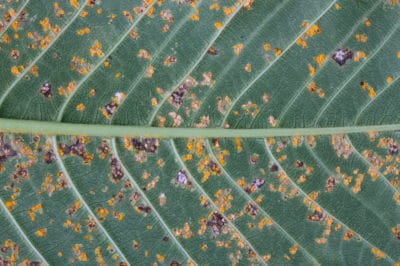Recognizing Fig Rust
Fig rust begins with tiny yellow spots on the underside of the leaves. As the rust spreads to the upper side of the leaf, the spots become reddish brown. Eventually the leaves will turn yellow and drop out of season. The fruit itself is not affected by the fungus, but a serious infection can cause premature ripening and excessive fruit drop.
Resistant Varieties
One way to decrease the risk of rust is to plant resistant varieties. While no fig is completely immune, these are reported to have some degree of resistance:
- Lages
- Western Santa Catarina
- Champagne
- Nero600m
- Adriatic JH
- LSU Purple
- Ischia Green
- Petite Negri.
Cultural Practices
Figs grow best in USDA Zones 8 through 11. If you are growing outside those zones and your area is more humid, you must take extra care. First, practice good sanitation – clean up leaf litter, cut off leaves or branches that show any signs of fungal problems and burn them immediately. Once the tree is dormant, remove and burn all leaves. Always grow figs in full sun.
Water, Humidity and Air Circulation
How and when you water figs is critical in more humid areas. Don’t run lawn sprinklers on fig trees – water only the ground under the tree. Water in the morning, so any water that splashes on the leaves or trunk has a chance to dry. Prune the tree to open it up and improve air circulation. Don’t crowd the tree with other plants, as crowded plantings impede circulation.
Fungicides
There is little you can do about rust when you actually discover it, as the damage to the leaf has already occurred. Unfortunately, few fungicides are registered for use on fig trees. Copper sulfate and lime seem to be the most effective. Spray the trees during the dormant season and repeat every two to three weeks. You can also spray with potassium bicarbonate – spray both tree and soil.
Give It Time
Luckily, fig rust is highly unlikely to actually kill the tree, although a seriously weakened tree may be more susceptible to other diseases and insect attacks. However, the spores overwinter in the ground and on plant debris. If you do a thorough clean up in late fall and spray the tree when it’s dormant, next years’ growth should be healthy.
